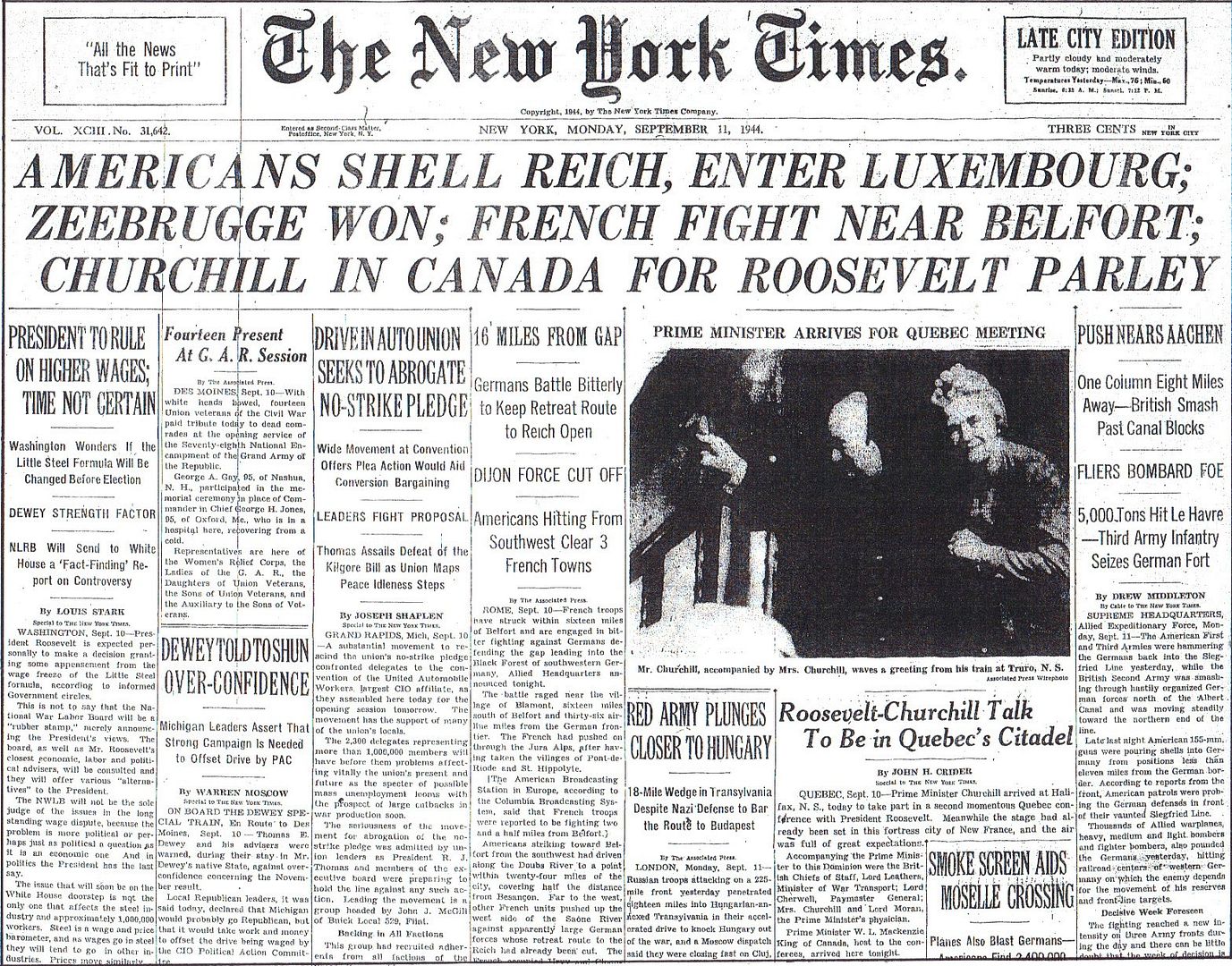
Posted on 09/11/2014 4:14:18 AM PDT by Homer_J_Simpson

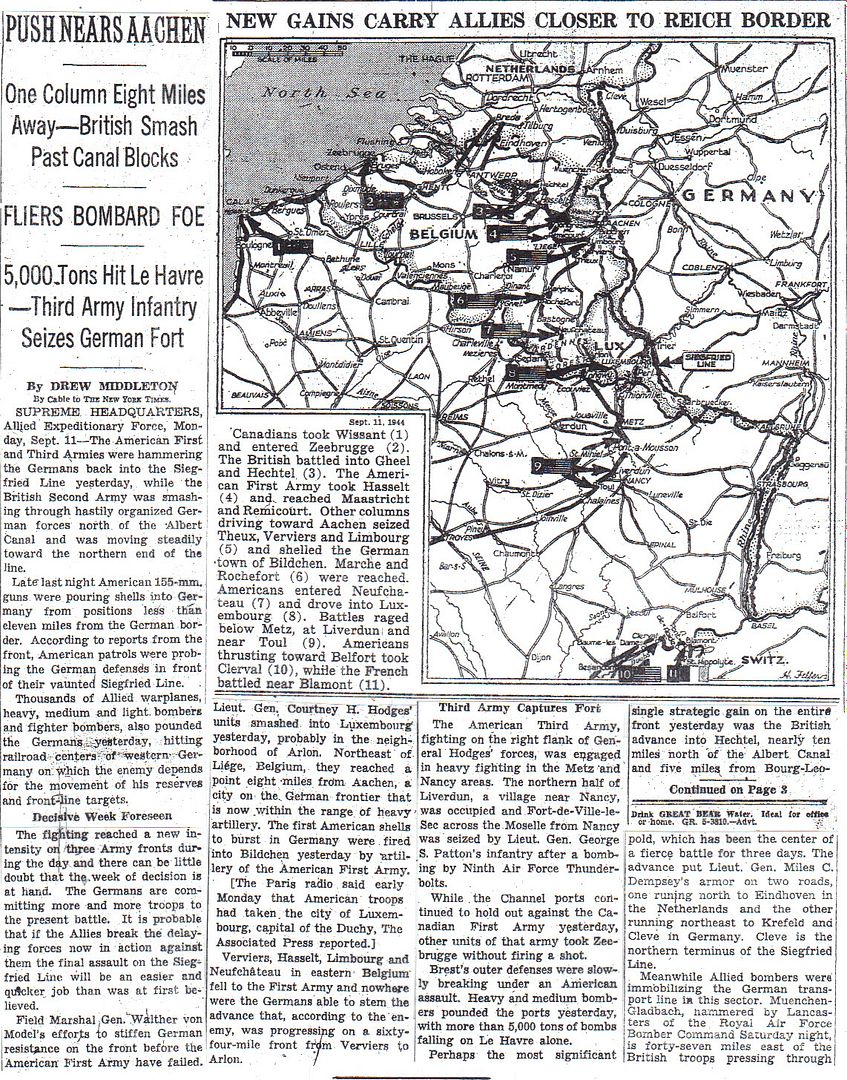

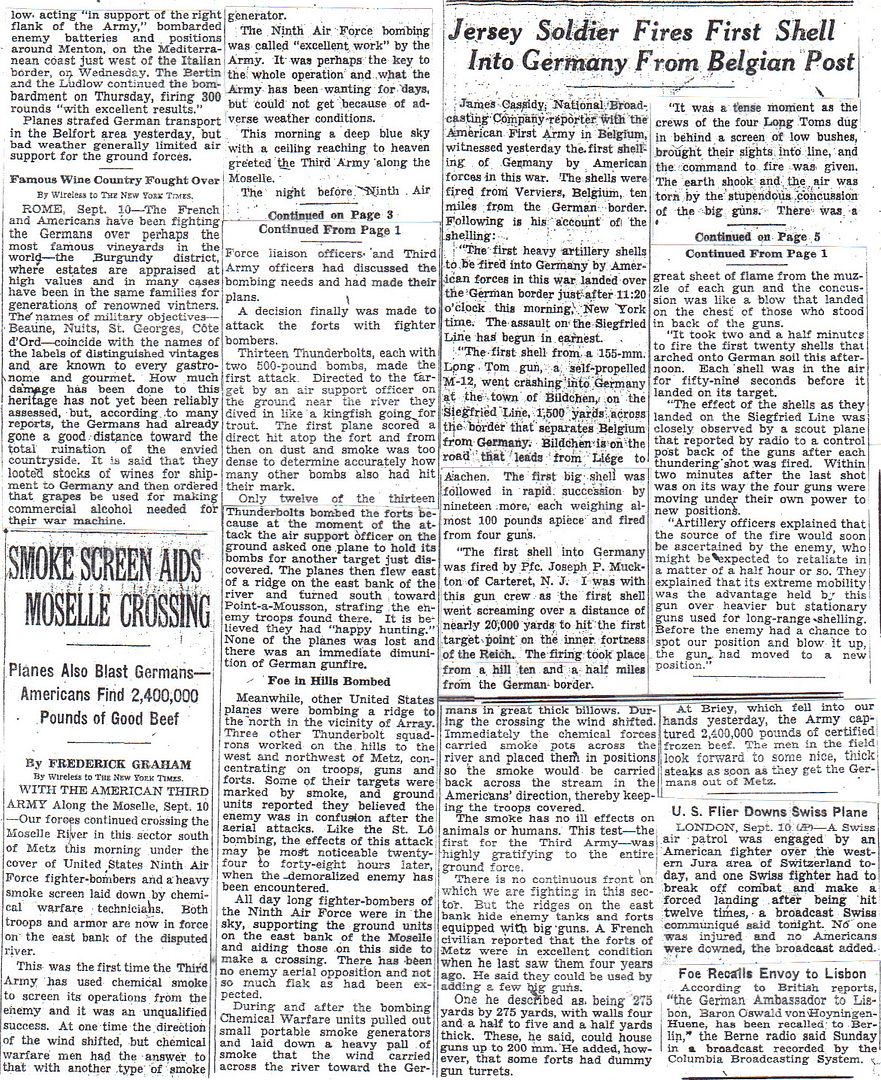
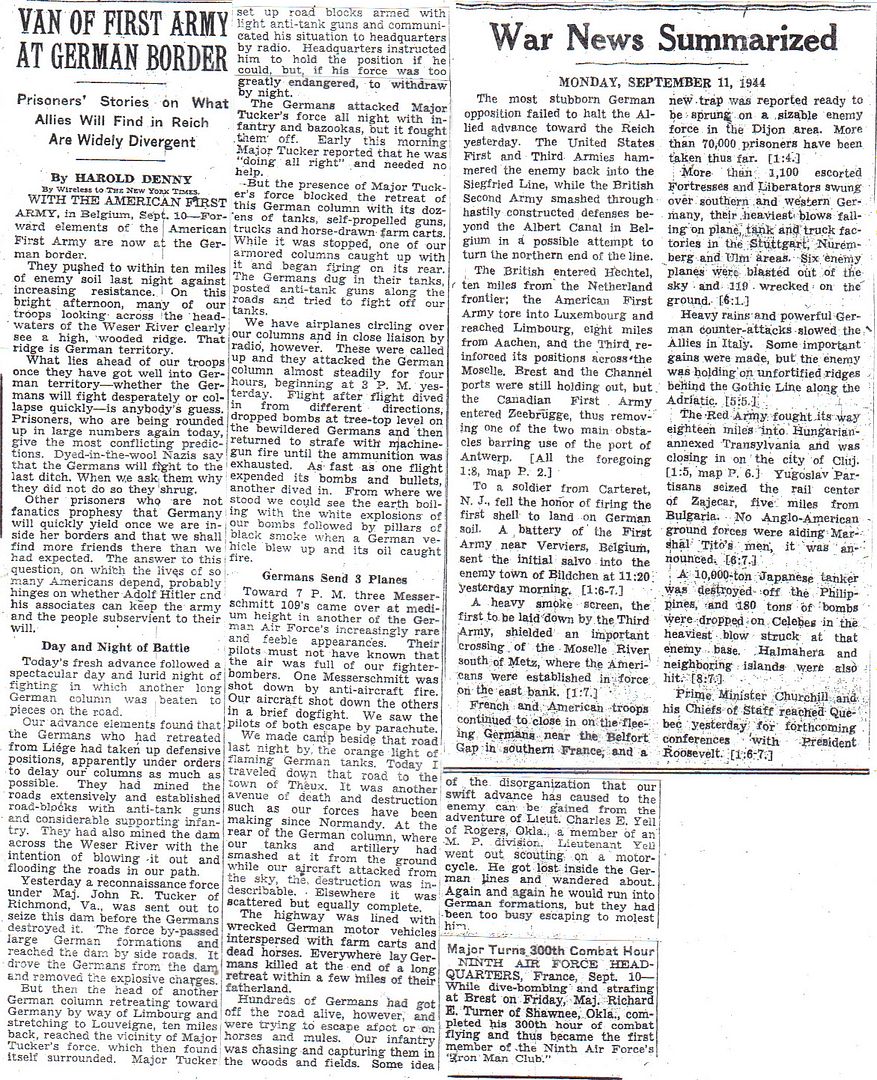
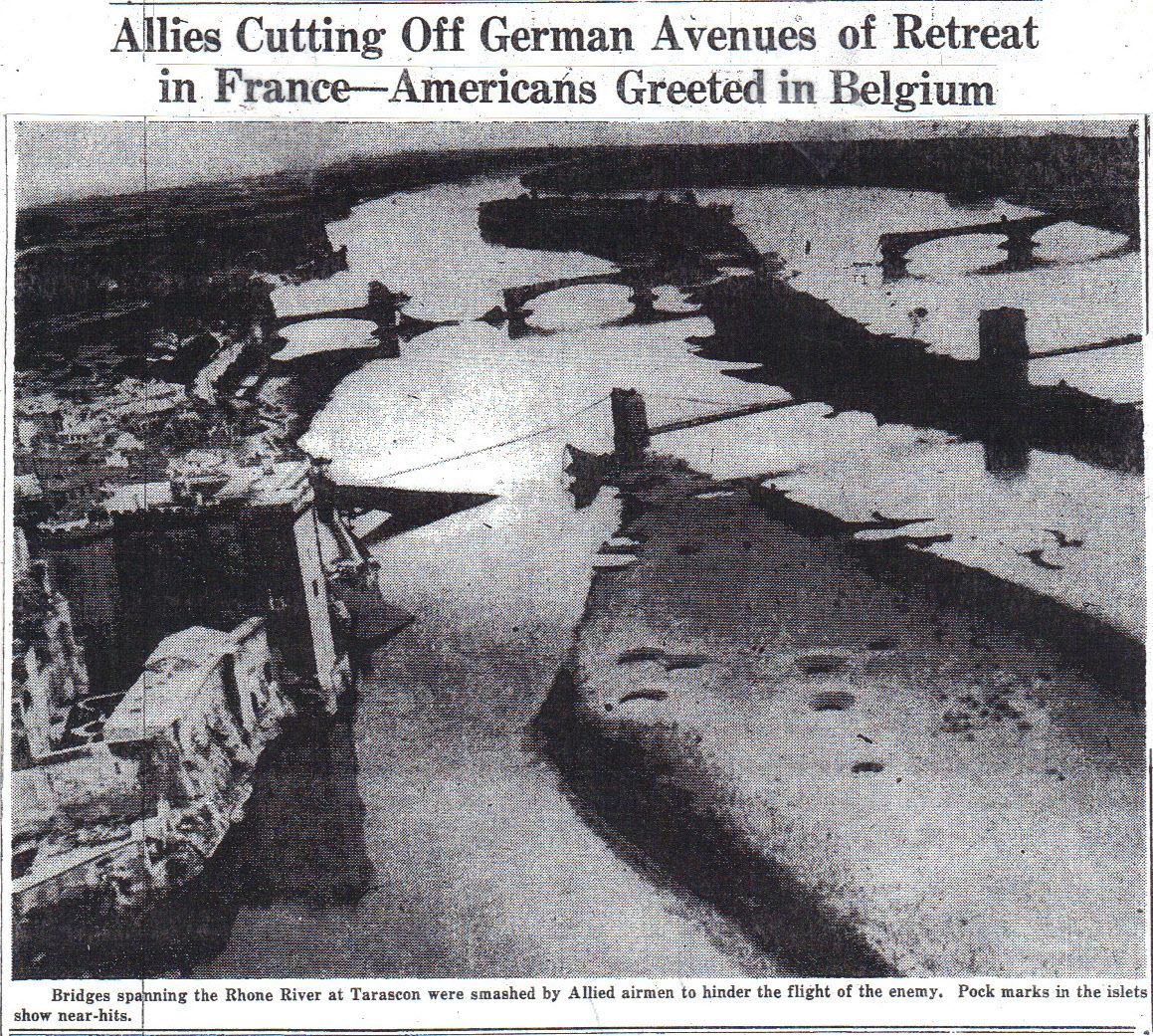
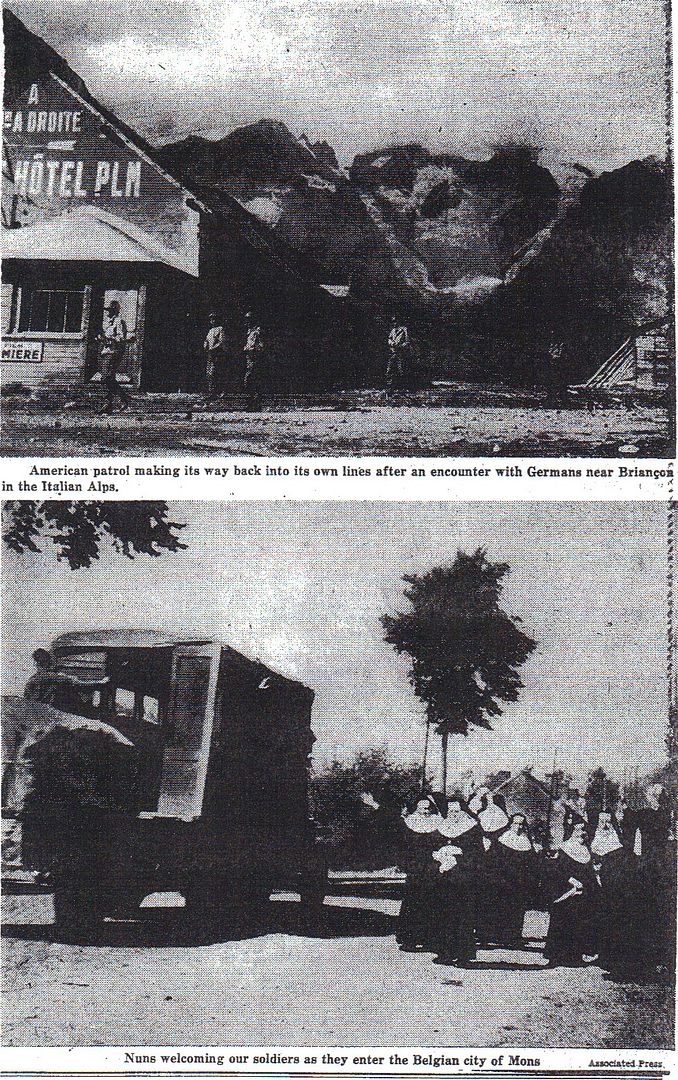


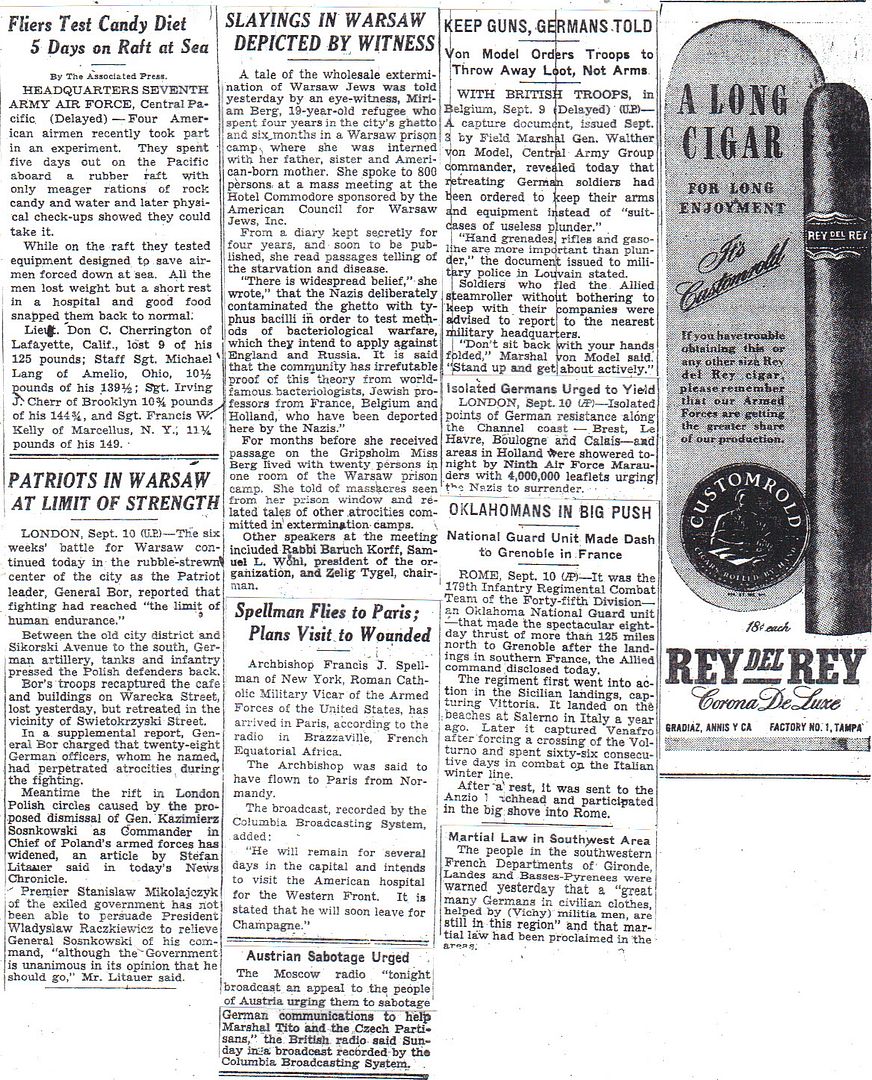
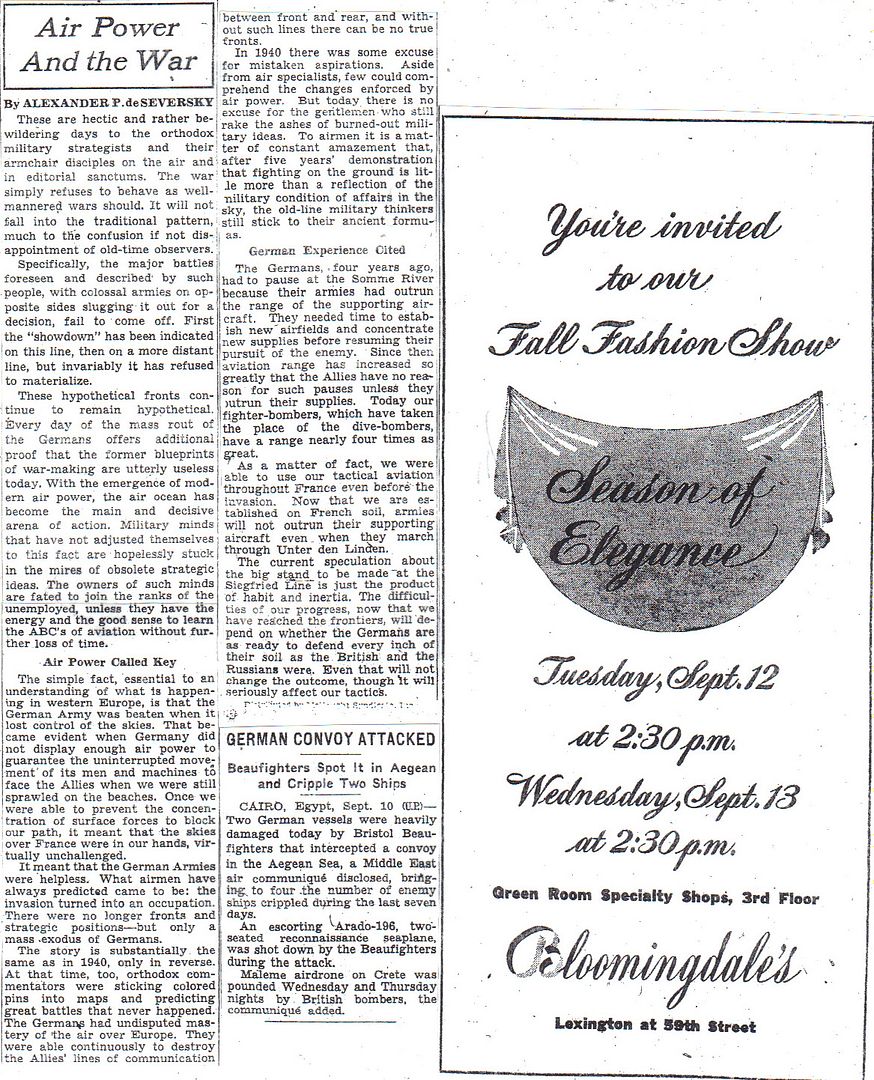
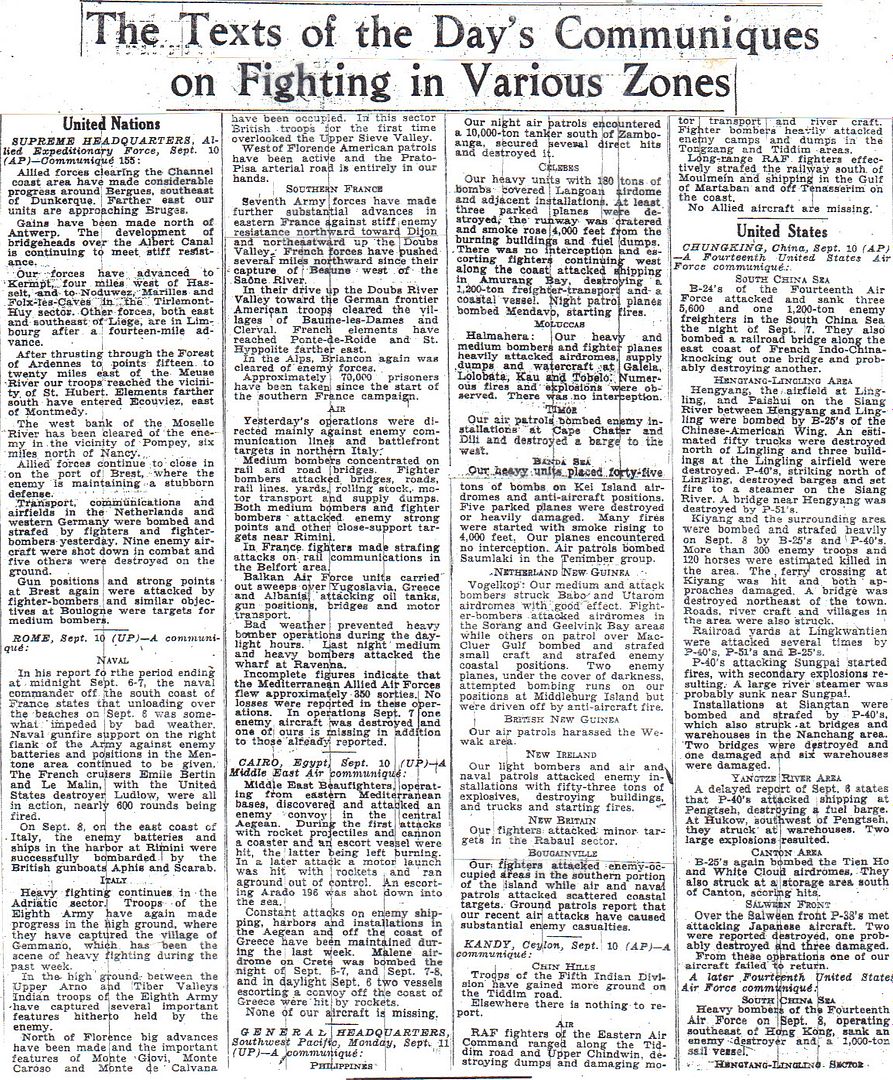
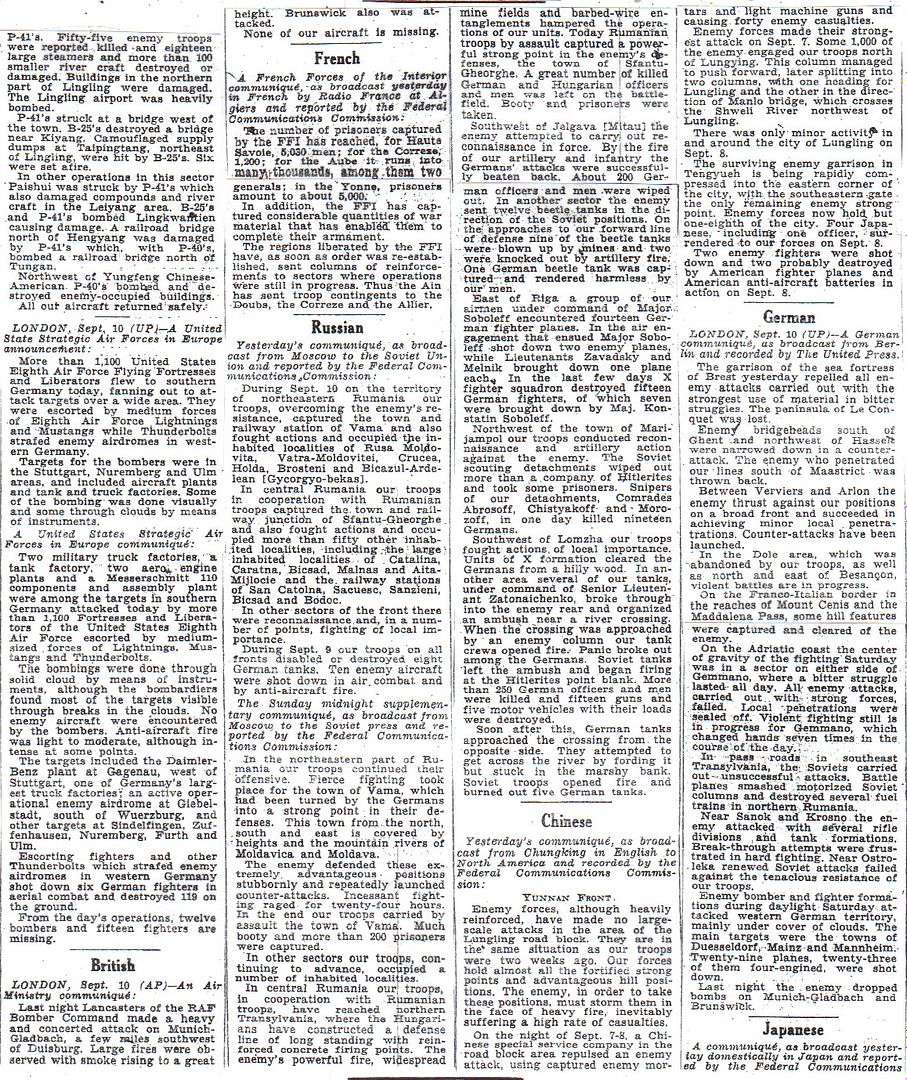
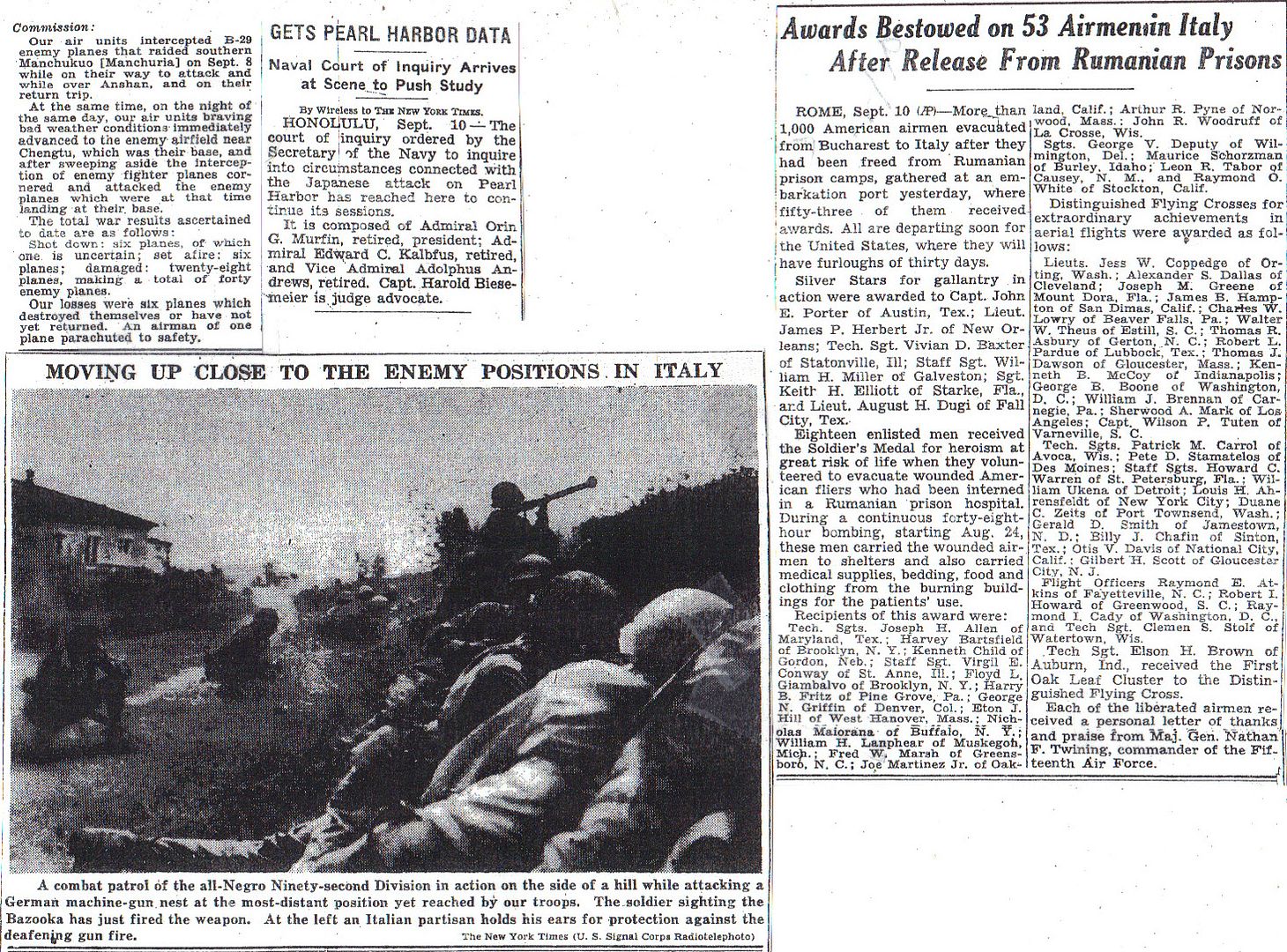
Push Nears Aachen (Middleton) – 2-3
16 Miles from Gap – 3-4
Smoke Screen Aids Moselle Crossing (Graham) – 4
Jersey Soldier Fires First Shell into Germany from Belgian Post – 4
Van of First Army at German Border (Denny) – 5
War News Summarized – 5
Allies Cutting Off German Avenues of Retreat in France-Americans Greeted in Belgium (photos) – 6-7
Red Army Plunges Closer to Hungary – 8
5,000 Planes Deal Blow at Germans – 9
Spirit of Revolt Reported in Reich (Axelsson) – 9
Air Power and the War (de Seversky) – 11
The Texts of the Day’s Communiques on Fighting in Various Zones – 12-14
Moving up Close to the Enemy Positions in Italy (photo) – 14
Awards Bestowed on 53 Airmen in Italy after Release from Rumanian Prisons – 14
http://www.onwar.com/chrono/1944/sep44/11sep44.htm#
Americans enter Germany
Monday, September 11, 1944 www.onwar.com
On the Western Front... After a heavy bomber raid by the RAF, elements of British 1st Corps (part of Canadian 1st Army) launch an assault on the German garrison cut-off in Le Harve. Forces of British 2nd Army enter Holland near Bourg Leopold and establish a bridgehead over the Meuse-Escaut canal. Leading elements of US 1st Army reach Germany north of Trier where Malmedy is occupied.
In Southern France... Lead forces of US 7th Army capture Dijon and link up with elements of French 2nd Armored Division (part of US 3rd Army) near Sombernon.
In Italy... In the west, forces of US 5th Army continue to advance. To the east, South African elements of British 13th Corps (part of British 8th Army) capture Pistoia.
In Canada... The Octagon Conference begins. Churchill and Roosevelt and their staffs meet in Quebec to discuss strategy.
http://www.etherit.co.uk/month/thismonth/11.htm
September 11th, 1944 (MONDAY)
UNITED KINGDOM: In England, the US Eighth Air Force flies 2 missions: Two missions are flown. Numbers in parenthesis indicate the number of bombers attacking a target.
- Mission 623: 1,131 bombers and 440 fighters, in 3 forces, are dispatched to hit synthetic oil plants and refineries in Germany; they encounter an estimated 525 Luftwaffe fighters; 40 bombers and 17 fighters are lost; the USAAF claim 115-7-23 aircraft in the air and 42-0-43 on the ground.
(1) B-17s bomb oil refineries at Bohlen (75), Chemnitz (75), Brux (39) and Ruhland (22); the Chemnitz force is an Operation FRANTIC force that along with 64 P-51 Mustangs, continues on and lands in the USSR; targets of opportunity are a tire plant at Fulda (66), a marshalling yard at Fulda (40) and 16 others; they claim 12-16-1 aircraft; 16 B-17s are lost; escort is provided by 252 P-51s; they claim 57-2-12 aircraft in the air and 26-0-25 on the ground; 4 P-51s are lost.
(2) B-17s attack oil refineries at Merseburg (111) and Lutzkendorf (96); targets of opportunity hit are Eisennach (71), Labejum (12), Rossla (6) and 25 others; they claim 1-1-2 aircraft; 13 B-17s are lost; escort is provided by 247 P-47 Thunderbolts and P-51s; they claim 13-0-1 aircraft in the air and 4-0-2 on the ground; 3 P-51s are lost.
(3) B-24s hit an engine factory at Hannover (88), oil refineries at Misburg (87) and Magdeburg (33) and an ordinance depot at Magdeburg (27); targets of opportunity hit are Magdeburg (70), Stendal (45), Diepholz (9) and 3 others; they claim 4-8-1 aircraft; 10 B-24s are lost; escort is provided by 164 P-38 Lightnings and P-51s; they claim 45-5-10 aircraft in the air and 12-0-16 on the ground; 10 P-51s are lost.
- Mission 625: 6 B-17s drop leaflets on France and Germany during the night.
- 38 B-24s fly CARPETBAGGER missions during the night.
BELGIUM: US 1st Army units take Malmedy.
NETHERLANDS: RAF Bomber Command dispatched seven Mosquitos to bomb Havelte Airfield at Steenwijk; three aircraft bomb the target.
FRANCE: In northern France, the British I Corps attacks Le Havre after a RAF raid.
Dijon is liberated in the south of France.
Orleans: Nearly 20,000 Germans surrender to the 83rd US Infantry Division.
In northern France, the USAAF Ninth Air Force continues tactical support of ground forces: 358 B-26 Marauders and A-20 Havocs, escorted by fighters, in support of the US Third Army, hit gun positions and strongpoints in the Metz area;, and support Third Army ground forces in the Metz area; fighters also support ground forces in the Brest area.
In southern France, the US AAF Fifteenth Air Force in Italy limits operations to supply mission by 54 B-24s to Lyons due to bad weather.
During the day, RAF Bomber Command dispatches 218 aircraft, 105 Halifaxes, 103 Lancasters and ten Mosquitos, to attack German positions outside Le Havre; 171 aircraft bombed the target. The bombing is carried out accurately in conditions of good visibility but the Master Bomber ordered the final wave to cease bombing because of smoke and dust. None are lost.
LUXEMBOURG: The U.S. First Army under Major General Courtney Hodges enters Luxembourg City and the liberation of the Grand Duchy from German occupation is completed. Lieutenant Colonel Edgar Jett is placed in charge of maintaining order and restoration of public services.
In northern FRANCE and GERMANY, the US Ninth Air Force continues tactical support of ground forces. 358 B-26s and A-20 Havocs, escorted by fighters, in support of the US Third Army, hit gun positions and strongpoints in the
Metz area; in GERMANY, fighters fly armed reconnaissance over the Lissendorf and Duren areas, and support Third Army ground forces in the Metz area; armored reconnaissance elements of this Army cross into Germany, the first Allied unit to do so; fighters also support ground forces in the Brest, France area.
GERMANY: Trier: American forces resuming their advance in the central sector today crossed the Germany/Luxemburg border north of Trier and began probing the Siegfried Line defences. In the north, other American forces crossed the Dutch border at Maastricht and are poised for a thrust on Aachen.
The first US unit to enter Germany was a recon element of the US 5th Armored Division (”Victory”), specifically Troop B, 2nd Platoon, 85th Cavalry at Stolzembourg.
“While the division was moving its units up to the border on 11 Sept., an order was sent out to the reconnaissance troops. It instructed them to cross into Germany as soon as possible and find out whether or not Wehrmacht soldiers were manning the pillboxes. In CCB’s zone, Captain Kenneth M. Hayes, commander of Troop B, 85th Cavalry Sq., assigned areas to his reconnaissance platoons to carry out this order. A few members of the 2nd Platoon, a patrol in charge of Sgt. Warner W. Holzinger, were the first Allied soldiers to enter Germany in World War II. It was 4:30 in the afternoon of 11 September when they crossed into the Reich at Stolzembourg. In addition to Sgt. Holzinger, this patrol consisted of: Cpl. Ralph E. Divin, T/5 Coy T. Locke, Pfc.William McColligan, Pfc.George F. McNeal, Pfc. Jesse Stevens. Sgt. Holzinger said, “When we started out on our mission, we took my radio peep with us to keep in touch with 2nd platoon and with headquarters. We worked our way down to Stolzembourg. From the citizens we learned there were no enemy soldiers in the vicinity. I have been thankful many times I could speak German.” (287) (Russell Folsom)
The British Second Army has broken out of its Albert Canal bridgehead, and advance units are moving into the Netherlands. A British spokesman said that during the operation more Germans were killed and more enemy equipment destroyed than in any one day since the Normandy landings began.
The roads into Germany are now packed with trucks, motor cars, and even bicycles, carrying soldiers and civilians fleeing the countries they have occupied for four years. These refugees are flooding into the Rhineland with atrocity stories, creating alarm and despondency among local people.
During the day, RAF Bomber Command dispatches 379 aircraft, 205 Halifaxes, 154 Lancasters and 20 Mosquitos, to attack three synthetic oil plants; 121 bomb the Klocknerwerke plant at Castrop Rauxel; 116 hit the Chemischewerke plant at Kamen; and 114 attack the Nordstern plant at Gelsenkirchen. The first two targets are clearly visible and are accurately bombed but the Nordstem plant is partially protected by a smoke-screen which hindered bombing and prevented observation of the results. The three forces are escorted by 26 squadrons of fighters, 20 squadrons of Spitfires and three each of Mustangs and Tempests. No German fighters are encountered. Five Halifaxes and two Pathfinder Lancasters are lost from the Nordstem raid and a Lancaster is lost from each of the other raids. These loss are caused by flak or by ‘friendly’ bombs.
During the night of 11/12 September, RAF Bomber Command sends 226 Lancasters and 14 Mosquitos to bomb Darmstadt; 234 aircraft bombed the city with the loss of 12 Lancasters, 5.3 per cent of the Lancaster force. A previous attack in August had failed to harm Darmstadt but, in clear weather conditions, the group’s marking methods produced an outstandingly accurate and concentrated raid on this almost intact city of 120,000 people. A fierce fire area is created in the centre and in the districts immediately south and east of the centre. Property damage in this area is almost complete. Casualties are very heavy. The Darmstadt raid, with its extensive fire destruction and its heavy casualties, is held by the Germans to be an extreme example of RAF “terror bombing” and is still a sensitive subject because of the absence of any major industries in the city. Bomber Command defended the raid by pointing out the railway communications passing through Darmstadt; the directive for the offensive against German communications had not yet been issued to Bomber Command, although advance notice of the directive may have been received. Darmstadt is simply one of Germany’s medium-sized cities of lesser importance which succumbed to Bomber Command’s improving area-attack techniques in the last months of the war when many of the larger cities are no longer worth bombing. A second target during the night is Berlin which is hit by 42 Mosquitos. Seventy six Halifaxes and Lancasters are dispatched on mine laying missions during the night: 17 laid mines in the Kiel area, 16 off Swinemunde, nine off Kattegat and seven in the Fehmarn Channel. Two Lancasters are lost off Swinemunde.
CZECHOSLOVAKIA: Thirty nine USAAF Eighth Air Force B-17 Flying Fortresses bomb a synthetic oil refinery at Brux using H2X radar. This is part of Operation FRANTIC that along with 64 P-51 Mustangs, continues on and lands in the U.S.S.R.
NORWAY: The Royal Navy midget submarine X-24 carried out a successful attack on a floating dock at Bergen, Norway. This was the second attack on the harbour by X-24 - she had survived a previous operation on 14 April 1944, when she had sunk a large merchantman and put the coaling wharf out of use for the rest of the war. Once again towed to the area by the submarine HMS Sceptre, X-24 laid two mines under the dock, which broke it in two and damaged two ships moored alongside. X-24 is preserved at the Royal Navy Submarine Museum, Gosport, the only remaining X-boat.
ITALY: The US 5th Army continues to advance. Pistoia is liberated by South African units of the British XIII Corps. In Italy, the US Twelfth Air Force continues tactical operations. B-26s hit defensive positions as US Fifth Army elements push through northern Italian mountain passes toward Gothic Line defenses; B-25s bomb railroad bridges at Vigevano and Canneto sull’Oglio and supply areas; fighter-bombers and fighters attack roads, railroads, guns, supply areas, bridges, and other targets at Vernio, and in the Alessandria, Turin, Piacenza, and Milan areas.
The US Fifteenth Air Force in Italy limits operations to supply mission by 54 B-24s to southern France due to bad weather.
FINLAND: The Finns and the Germans start secret negotiations about the German withdrawal from northern Finland at Rovaniemi. The Soviet-imposed deadline for the German withdrawal is only four days away, and it is evident the Germans are unable to leave Finland in time. However, both armies are willing to avoid bloodshed, and agreement is reached. Germans would retreat according to a prearranged plan, destroying roads and bridges, while Finns would advance slowly to areas already abandoned by Germans. The slow rate of Finnish advance could be excused by the German policy of scorched earth. While the negotiations are going on, the Swedish government has already agreed to receive the Finnish civilian population wishing to leave the German occupied areas.
BURMA 23 US Tenth Air Force B-24s fly fuel to Kunming, China; numerous other transport flights throughout the CBI continue.
CHINA: 12 US Fourteenth Air Force P-40s blast trucks along Burma Road and around Lungling; 59 P-40s and P-51s hit river shipping, railroad targets, troop concentrations, supply dumps, and other targets of opportunity in the Canton-Tungting Lake area.
KURILE ISLANDS: 4 US Eleventh Air Force B-25s on a shipping search sink a small craft off Shimushu Island; 2 other B-25s fly a search mission for a B-25 (which force-landed in USSR on 9 September but is still reported as missing).
VOLCANO ISLANDS: Saipan-based B-24s of the USAAF Seventh Air Force bomb Iwo Jima and damage a Japanese cargo vessel; difficulties encountered in attempting to tow the damaged craft result in her being scuttled.
SOUTHWEST PACIFIC: US Far East Air Force B-24s hit airfields at Galela and Miti on Halmahera Island. B-25s bomb Kairatoe Airfield and village on Celebes Island and Boela Airfield on Ceram Island while P-38s hit airfields at Namlea on Buru Island and Amahai and oil tanks at Boela, Ceram Island. A-20s and B-25s hit Kaoe Airfield on Halmahera Island and scattered targets of opportunity. In New Guinea, A-20s strike Otawiri, Sagan, Nabire, and Urarom Airfields while fighter-bombers hit airfields and AA guns at Manokwari and Ransiki.
CAROLINE ISLANDS: PALAU ISLANDS: Carrier-based aircraft of the USN’s Task Group 38.4 continue preinvasion attacks on airfields and Japanese installations; they also sink a Japanese cargo ship 2 miles (3,2 kilometres) off the coast. During the night, USAAF Thirteenth Air Force radar-equipped B-24s attack the airfields and defensive positions.
MARIANA ISLANDS: The USN destroyer USS Ellet (DD-398) bombards supply dumps on Aguijan Island.
AUSTRALIA: British submarine HMS/M Porpoise (N 14) sails from Freemantle, Western Australia, with a 23-man commando party participating in Operation RIMAU, an attack on Japanese shipping in Singapore Harbor. This raid emulated Operation JAYWICK in September 1943 when Australian commandoes attacked shipping in Singapore. However, unlike the previous attack this attack fails. The submarine successfully drops the commandos at their start point, but then things go wrong; the commandos are discovered, and in engagements with the Japanese, 13 men are killed or die of wounds. The remaining ten are captured. On 7th July 1945, the ten men are executed by the Japanese.
PACIFIC OCEAN: US submarines sink the Japanese transports RAKUYO MARU and KACHIDOKI MARU killing 1,274 Allied PoWs en-route from Singapore to Formosa.
USN submarines also sink four other Japanese ships: (1) USS Albacore (SS-218) sinks an auxiliary submarine chaser off Kyushu, Japan; (2) USS Finback (SS-230) sinks an army cargo ship and a merchant cargo ship north of Chichi Jima, Bonin Islands; and (3) USS Pargo (SS-264) sinks an auxiliary netlayer in the Java Sea, Netherlands East Indies.
CANADA: The Octagon Conference at Quebec begins hosted by Canadian prime minister William Lyon Mackenzie King at the Chateau Frontenac. Churchill and Roosevelt with their staffs meet to discuss overall strategy of the war. The plans for continued attacks in Italy and Northern Europe are not changed. British attacks in Burma are approved. British Fleet participation in the Pacific is approved for the final campaigns against the Japanese. This conference will last until the 16th.
U.S.A.: Destroyer escort USS Grady commissioned.
ATLANTIC OCEAN: The German submarine U-855 is listed as missing in the area west of Bergen, Norway. The 56-men aboard the sub are lost.
I continue to be impressed by the daily tallies of Japanese merchant ship losses. The Silent Service has hit its stride. Japan is being strangled. We’re doing to them what Donitz tried, but could not do to the British.
de Seversky actually got something right in his last paragraph as to whether we can sustain the progress we've been making in France as we prepare to enter Germany.
It will depend on "whether the Germans are as ready to defend every inch of their soil as the British and the Russians were."
Turns out they were, at least until Berlin falls and Hitler is dead.
They finally got torpedoes that actually worked.
A very prescient comment by the writer.
Thanks for pointing that out. I had missed it.
It sounded from yesterday’s news and comments that at least the planning of Monty’s ill-conceived & ill-fated “Market-Garden” has begun to adversely affect other operations in the area.
Do you know when the actual Market-Garden operation begin and from where to where was it supposed to go? (I think M-G is what the movie, “Bridge too Far” is about.)
Coming up next week. Eisenhower approved the Market-Garden operation yesterday. Montgomery will issue the order to his command on the 14th and the first airborne forces will go in early on the 17th.
As per Wiki: Operation Market Garden (17–25 September 1944) was an unsuccessful Allied military operation, fought in the Netherlands and Germany in the Second World War. It was the largest airborne operation up to that time.
Yes, “Bridge too Far” is a fictional account of MG.
Yes, the movie A Bridge Too Far is about the operation. It was based on an earlier book of the same name by Cornelius Ryan. It refers to the fact that of the five major bridges they needed to take to get completely across the Rhine, they took four.
MG had two bad effects (besides cutting up British 1st Airborne pretty badly), it stopped any drive to take the Scheldt immediately, devoting those troops to the MG plan, meaning Antwerp will be useless as a port for some time. And it diverted scarce supplies from the American First and Third Armies, who were gaining ground, and diverted them to the British.
If I’m reading the map correctly, it looks like the fifth river that was “too far” to cross was Lek River.
I assume that Monty’s idea (hard not to believe he was mentally racing Patton to Berlin for the glory) was that if they had secured the last bridge over the Lek River, he and the British would have had a straight shot over the Northern German Plain to Berlin, beating Patton.
I have made my views clear before that I don't think Monty was capable of "dashing" anywhere.
We have previously discussed a glaring error in Monty's plan, that he will not have supplies to sustain an advance deep into Germany until he takes the Scheldt and opens Antwerp port. But he diverted those troops to support MG.
I am speculating, but I agree with you that Monty's ego was behind this. He must have fumed as Patton got all the headlines while he was still plodding in Normandy. And, opening the Scheldt would not give him spectacular headlines. Also, if he could get into the Plain he could renew his demand for supply priority because Hodges and Patton are facing some tough nuts to crack in the Siegfried Line and getting across the Rhine themselves, so they are not yet in a position to make a run to Berlin.
I gotta believe Messina was also rattling around in the back of Monty’s mind.
“Messina, Bell.
Messina. . .
. . .is the heart of it. lf they’d
followed my plan, I’d be there by now.
I’d cut off the retreat of every
German on this island!
Now, you know what I’m gonna do?
I’m gonna go to Palermo.
I’m gonna beat that limey at Messina
if it’s the last thing I ever do!”
Can we say "pencil-like thrust?" Yes, I knew that we could. Just what Ike thought Monty was proposing in his "dash to Berlin" plan. Colorado, I think you hit the nail on the head with your observation that Monty was prodded by Patton's success, and very jealous. Even Patton would not have sanctioned this plan. It wasn't feasible.
I had always thought the followup plan was to turn south and drive in behind the Rhine toward the Ruhr. That’s the first I’ve seen that they planned to turn north, away from Germany.
Disclaimer: Opinions posted on Free Republic are those of the individual posters and do not necessarily represent the opinion of Free Republic or its management. All materials posted herein are protected by copyright law and the exemption for fair use of copyrighted works.